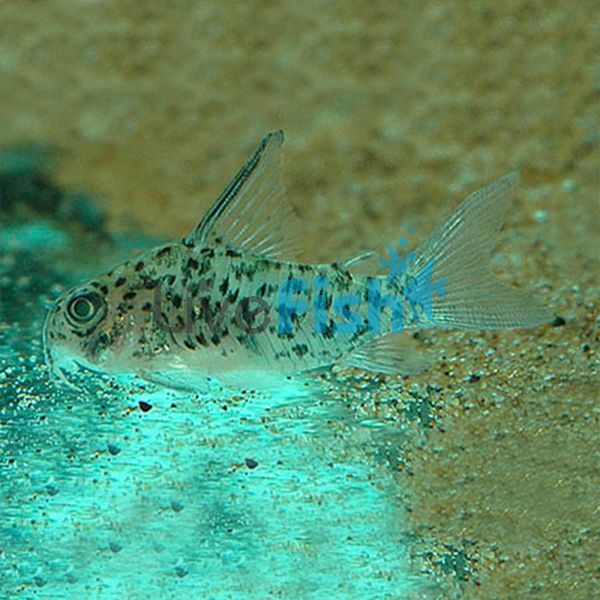Armatus Corydoras - Wild Caught 4.5cm
There is a really unique and dedicated fanbase for Corydoras because of how fun these fish are to keep and how many different species there are. Corydoras has almost become a collector's style fish and with the rarity of some species in Australia, the hype for the is ever-growing. One of these rarer species is the armatus Corydoras which has easily got one of the most different body shapes and colours compared to other cories. This species also stays at a small size of 5 cm which will make them a great species for a South American display tank.
Armatus Corydoras
There is a really unique and dedicated fanbase for Corydoras because of how fun these fish are to keep and how many different species there are. Corydoras has almost become a collector's style fish and with the rarity of some species in Australia, the hype for the is ever-growing. One of these rarer species is the armatus Corydoras which has easily got one of the most different body shapes and colours compared to other cories. This species also stays at a small size of 5 cm which will make them a great species for a South American display tank.
Armatus corydoras look really different in their body shape as their back raises up much higher compared to other cories. The name of their back leads to the dorsal fin which is much taller than other species which gives them a bottom-dwelling shark appearance. Aesthetic wise the armatus corydoras have a very light body colour with a speckling of black which would blend in perfectly with a natural gravel substrate in the wild. This species can develop a light green sheen across the body as well when they reach maturity which contrasts well with their lighter colour. Just like any other corydoras species armatus species will constantly stir the substrate layer in order to look for food. This behaviour ensures they are keeping the substrate turned over and any debris in the water column, which can then be picked up by the aquarium filter. They are almost exclusively bottom-dwelling fish and are an awesome option to add some life to the bottom of the tank.
The armatus corydoras should not be a shy fish but they may take some time to settle into the aquarium due to their wild nature. These fish are also considered to be schooling catfish and considering the value of these fish, it would be best to keep them in a school of at least 5-6. Differentiating males and females is possible where the males are often smaller and narrower compared to the larger-bodied females. The best method to identify is to get a school and let a pair naturally form. Females are often triggered to spawn after being fed high-quality food and a slight reduction in the temperature. The wild origin of the armatus corydora is South America.
Tank Recommendations for your Armatus Corydoras
As armatus cories reach around 5 cm as adults it is best to keep them in an aquarium with a minimum size of around 70 litres. A larger aquarium will always be better due to showing them off since these fish would be perfect in a high-end and peaceful South American system.
A sand substrate is best as coarser substrates like gravel often result in corydoras damaging their barbels. The armatus cory would look best against a lighter substrate. Though they have a light body colour the black spots will really contrast against a lighter sand colour. They will also love plants in the aquarium and places for cover through the addition of driftwood.
Suitable Tank Buddies
Armatus corydoras is an incredibly peaceful fish that can be kept in an absolutely massive range of community aquariums. They do not display any aggression even when breeding and make for a perfect addition even with sensitive or shy fish. The obvious consideration would be to just avoid keeping anything that might harm this fish.
Usually Compatible
Angelfish, cardinal tetras, rams, discus, and similar peaceful South American species.
Sometimes Compatible
Mystus catfish, convict cichlids, pearsi cichlids, and other peaceful territorial species.
Rarely Compatible
Large and aggressive species such as the Oscars may prey on the Corydoras. This is especially important as Corydoras have spines on their pectoral fins like many catfish, this can result in both the corydoras and the predator fish’s death.
Feeding your Armatus Corydoras
Just like any other corydoras these fish are very easy to feed. They will take a wide range of pellets, flakes, and frozen foods. Just like any fish though they should be fed a varied diet with a mix of different foods.
The ideal diet would be a good quality micro slow-sinking pellet or crushed flake, supplemented with frozen bloodworms or black worms or even live foods like baby brine shrimp or micro worms.
| Scientific Name | Corydoras armatus |
|---|---|
| Care Level | Moderate |
| Common Names | Corydoras armatus |
| Diet | Carnivore |
| Fish Family | Callichthyidae |
| Lifespan (years) | 10 |
| Max. Length (cm) | 5 |
| Min. Tank Volume (l) | 70 Liters |
| Origin | South America |
| Reef Safe | Yes |
| Sociability | Peaceful |
| Venomous | No |
| Water Conditions | 24-26° C, pH 6.0-7.0 |




